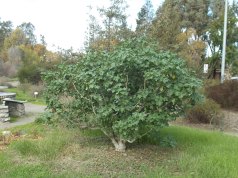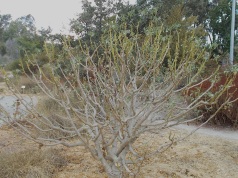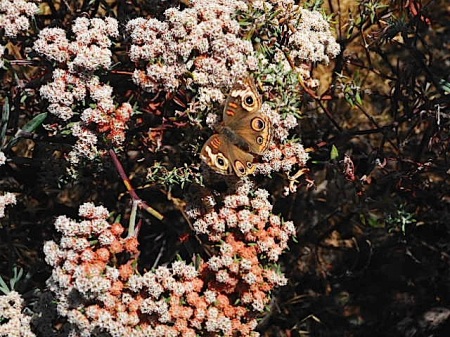 It’s a Mallow With apologies to Shakespeare and Gertrude Stein (“A rose is a rose is a rose …”), the malva rosa is not a rose. Not even close. It’s a mallow, a rosy mallow. Also known as island tree mallow, it belongs to the family Malvaceae, of which there are two other representatives at the Granada Native Garden (bush mallow, or Malacothamnus fremontii, and globe mallow, Sphaeralcea ambigua). In the same family are okra, cocao, cotton, hollyhock and hibiscus, as well as the pesty (but reportably edible) non-native cheeseweed (Malva parviflora) which we relentlessly pull out every year all over the Garden.
It’s a Mallow With apologies to Shakespeare and Gertrude Stein (“A rose is a rose is a rose …”), the malva rosa is not a rose. Not even close. It’s a mallow, a rosy mallow. Also known as island tree mallow, it belongs to the family Malvaceae, of which there are two other representatives at the Granada Native Garden (bush mallow, or Malacothamnus fremontii, and globe mallow, Sphaeralcea ambigua). In the same family are okra, cocao, cotton, hollyhock and hibiscus, as well as the pesty (but reportably edible) non-native cheeseweed (Malva parviflora) which we relentlessly pull out every year all over the Garden.
Malva rosa (Malva assurgentiflora) used to be named Lavatera assurgentiflora, and it is still often sold under that name. (And in case you are wondering, marshmallows originated when the roots of another member of the mallow family, Althaea officinalis, were boiled with sugar until thick. Now, of course, marshmallows are made from sugar, water and gelatin, and puffed up with air, not anything related to the mallow plant.) (Photos can usually be enlarged by clicking on them.)
Shy But Water-Wise The showy but shy blossoms have the habit of hiding somewhat within the interior of the tree, so that they are not readily seen without a closer look. Their color has been described as red with white stripes, or white with red stripes. (Personally, I tend to prefer “cerise” or “magenta”.)
Like many of the California natives growing in the “California Floristic Province”, malva rosa is native to California but not necessarily to the part of California where we want to grow it. In this case, malva rosa is specifically native to the Channel Islands, a chain of eight islands in the Pacific Ocean along the Santa Barbara Channel, where the climate is moderated by the moist ocean air with high humidity (often between 60%-100%), frequent fog, and unpredict- able but usually abundant rainfall. The Channel Islands are included within the boundaries of the California Floristic Province.
This means that malva rosa evolved to grow in a less hostile environment than the hot, dry California interior. While this difference makes it difficult to grow some California natives where we might hope to enjoy them, this hasn’t prevented malva rosa from escaping its homeland and thriving in mainland California, as long as the soil has good drainage and it receives some summer water.
At the Granada Native Garden in hot, dry Livermore, malva rosa survives by being “drought deciduous” or “summer deciduous”. This means that, as the weather gets warmer and dryer, it retains only as many leaves as the available water can support, and drops the rest. The poor thing can look to be on death’s doorstep at the end of summer, but only until the winter rains begin, when it bursts into new foliage. And in 2016, we had a good start on the seasonal rainfall in mid-October (see the photos below; they can be enlarged by clicking on them).
Other Fun Facts about Malva Rosa! Malva rosa is a fast grower. Ours was planted in fall, 2012, and now stands about 8 feet tall and about 10 feet wide. It needs vigilant pruning to maintain its shape and size, and keep its interior from getting too crowded. It drops numerous seeds which readily sprout beneath its branches (but we have not yet tried to transplant any of these). The leaves seem to be a popular gathering place for numerous insects of various types, such as spider mites, thrips, lace bugs, psyllids and whiteflies, altho none of these have so far proved to be pests or bothersome. Watershed Nursery reports that malva rosa was used by Native Americans to treat broken bones, sores, swelling and injuries.
Current Attractions at the Granada Native Garden Summer is not the most colorful time of the year at the GNG, but nevertheless there are plenty of attractions to enjoy, colorwise or otherwise. Furthermore, we have been getting better at placing easily readible marker placards in front of many of the plants. So here are some of the attractions that might tempt you to visit before summer ends. Buckwheat is abundant and very much in bloom at this time of the year at the Granada Native Garden. Its white pom pom-like blossoms gradually turn to pink, then to copper, then to chocolate, as the season progresses. Two of the most prominant buckwheats of this description at the GNG are California buckwheat (Eriogonum fasciculatum) and Santa Cruz Island buckwheat (E. arborescens), but not to be missed is red buckwheat (E. grande rubescens) with its showy red blossoms, but they are starting to fade. All of the buckwheats are great butterfly and honeybee plants. For more information about buckwheats, use the Newsletter Index to look up the article about buckwheats published in June 2013.
Three recent arrivals located in the general vicinity of the tables are the bed of red California fuchsia (Epilobium californicum, donated to us by Rob DeBree of Elkhorn Native Nursery), a field of bright yellow California goldenrod (Solidago velutina), and a small but expanding patch of lavender California aster (Symphyotrichum chilense).
Yarrow (Achillea millefolium), featured in the March, 2017 issue of the Newsletter, is still in bloom at various locations at the Garden, altho much of it is “over the hill”, but retains its own “brown is a color” personality.
Closer to the center of the Garden, you can find bladderpod (Peritoma arborea), with its yellow blossoms and its foliage smelling like sauteed bell peppers and onions. Read about it in the February issue of the Newsletter. Speaking of plant aromas but not currently in color, but looking lush and spilling over the pathway is mugwort (Artemesia douglasiana). Its cousin, sagebrush (Artemesia californica), with its totally different physical appearance but similar distinctive pleasant medicinal aroma, is growing along the path at the other side of the Garden near Murrieta Blvd. Along the Arroyo Mocho bike trail is a large (and growing larger) field of gumplant (Grindelia camporum or G. stricta, we’re not sure, probably both!), with its sticky yellow blossoms and sticky leaves and sticky flower heads. Give them a feel! Finally, yampah (Perideridia sp., aka “Indian potatoes”) is taking over the triangular area formerly monopolized by the elderberry (Sambucus mexicana, featured in the August, 2013 Newsletter. The berries are forming now, but a few weeks ago the blossoms were emitting the unmistakable aroma of cloves as you passed by. The elderberry gets cut down to 5-6 feet every winter, but quickly grows to its full height within the next few months. And if you are looking for a native California grass with a tall, graceful appearance but doesn’t turn dormant during the summer, there is a patch of alkali sacaton (Sporo- bolus airoides) nearby.
Quote du Jour “It is the time you have spent on your rose that makes your rose so important.” – Antoine de St. Exupery (author of “The Little Prince”)
Check out the native plant selection at ALDEN LANE NURSERY, 981 Alden Lane, Livermore, CA 94550
For reliable certified arborist services, contact STUMPY’S TREE SERVICE, (925)518-1442, http://www.stumpystrees.com .
 Guided Tours of the Granada Native Garden Are Available! Are you interested in seeing some of the plants that are described in this News- letter or in past issues? One or more staff of the GNG are routinely on duty at the Garden on Mondays and Thursdays, roughly between 10:00 AM and 12:00 noon. But it isn’t very hard to arrange a guided visit at other times. If you are interested in scheduling a visit, just email Jim at JIMatGNG@gmail.com . Or if you have any questions or inquiries, please email Jim at the same address!
Guided Tours of the Granada Native Garden Are Available! Are you interested in seeing some of the plants that are described in this News- letter or in past issues? One or more staff of the GNG are routinely on duty at the Garden on Mondays and Thursdays, roughly between 10:00 AM and 12:00 noon. But it isn’t very hard to arrange a guided visit at other times. If you are interested in scheduling a visit, just email Jim at JIMatGNG@gmail.com . Or if you have any questions or inquiries, please email Jim at the same address!









